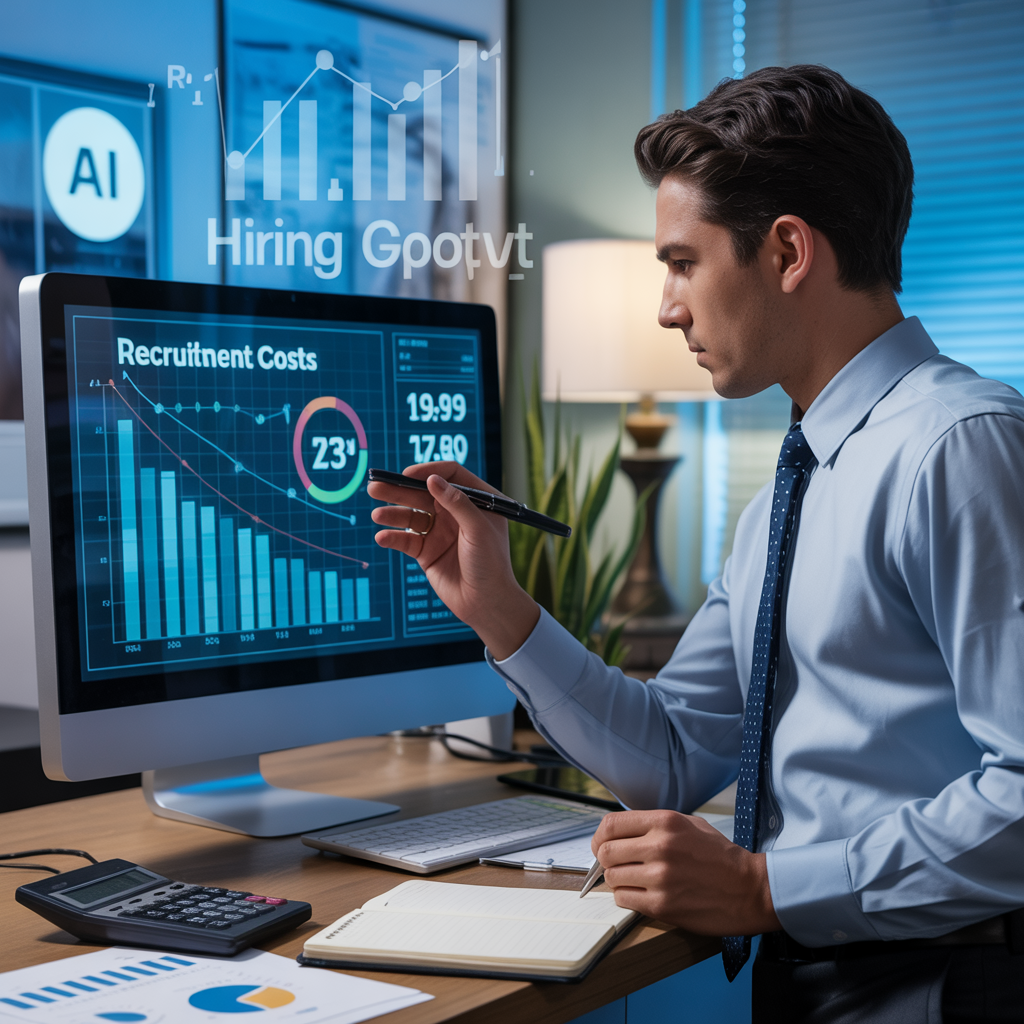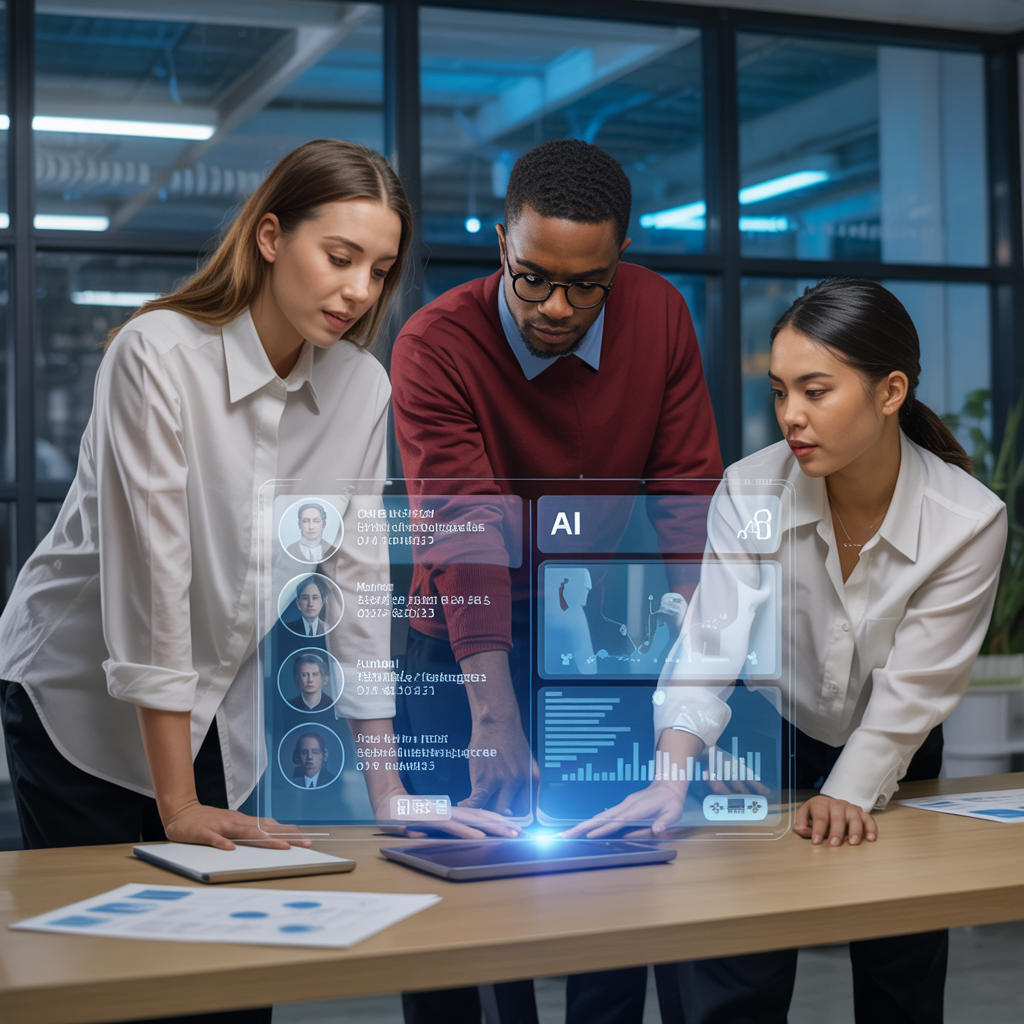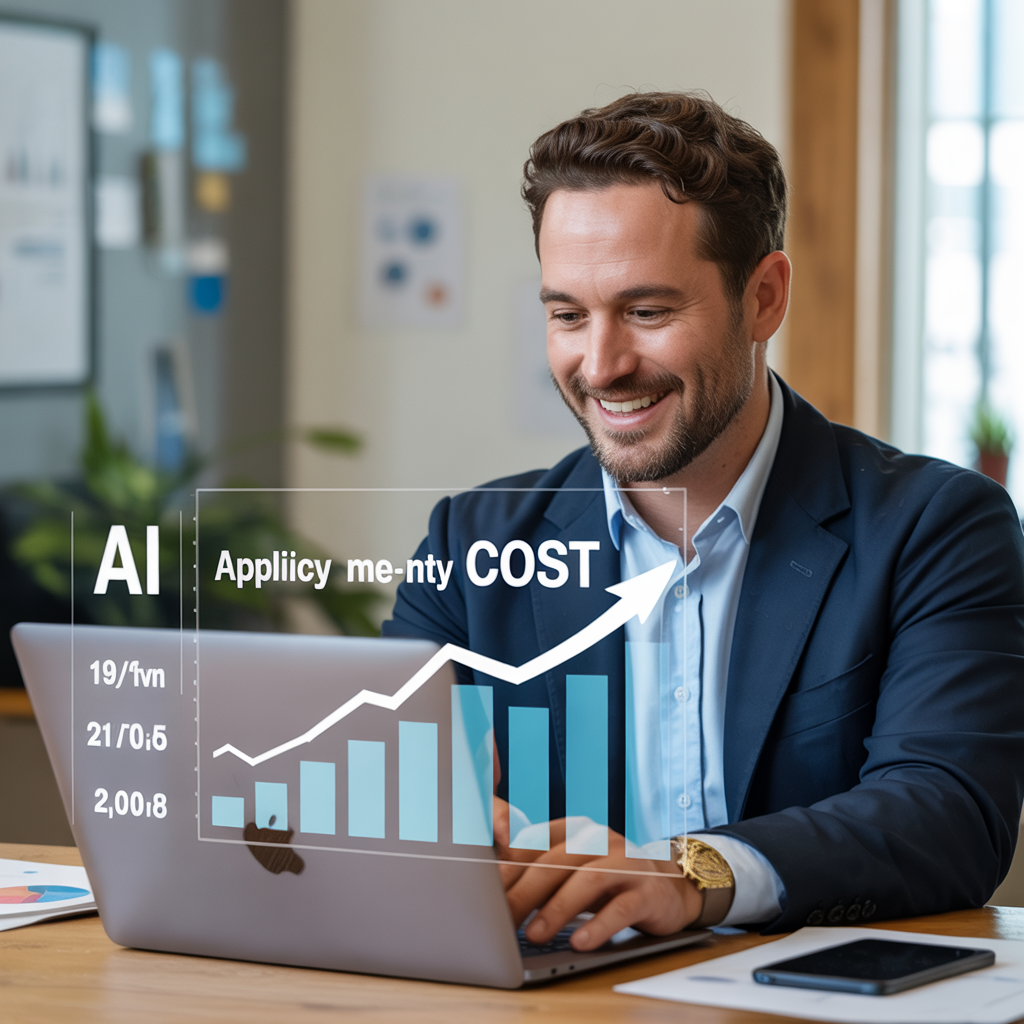AI Ads: 3× Applicants, Half Cost

You’re staring at a dashboard showing your job ad’s stats: 5 applicants after spending $500. Depressing, right?
Now imagine that same dashboard showing 15 qualified candidates while spending just $250. That’s exactly what happened when we tested AI-driven recruitment advertising against traditional methods.
The secret? AI job ads don’t just cast a wider net—they cast a smarter one. By analyzing what actually makes candidates click, apply, and stick around, artificial intelligence transforms how companies find talent in today’s brutal hiring market.
Our clients are seeing 3× the applicants at half the cost. But here’s what keeps me up at night: why are so many recruiters still throwing money at outdated advertising methods when the data is this clear?
The AI Revolution in Recruitment Advertising

How AI transforms traditional job advertising
Gone are the days when recruitment meant posting a static job ad and praying for applications. AI has flipped the script completely.
Traditional job ads were like shooting in the dark – one generic message blasted everywhere, hoping someone relevant might see it. AI-powered recruitment platforms now analyze candidate data, job-seeking behaviors, and market trends in real-time.
The magic happens when these systems start personalizing job ads for different audiences. An engineering role can be presented differently to a senior developer versus a recent graduate. The AI tailors everything – the wording, benefits highlighted, even the imagery used.
What’s truly revolutionary is the predictive capability. These systems learn which channels, messages, and timing work best for specific roles. They automatically optimize your spend where you’re getting actual results, not just impressions.
Real success metrics: Triple the applicants
The numbers don’t lie. Companies using AI-driven recruitment ads are seeing 3× the qualified applicants compared to traditional methods.
Why such a dramatic jump? The targeting is simply better. When your job ad appears in front of the right people at the right time with the right message, magic happens.
Take this breakdown from our recent client data:
| Metric | Traditional Ads | AI-Powered Ads |
|---|---|---|
| Qualified applicants | 15 per posting | 45+ per posting |
| Time-to-fill | 42 days | 18 days |
| Diversity of candidate pool | Limited | 68% more diverse |
Cost efficiency: Cutting advertising spend by 50%
The math is simple but the impact is massive. Companies are slashing their recruitment ad budgets in half while getting better results.
How? AI eliminates waste. Traditional job advertising burns money on:
- Irrelevant placements
- Ineffective channels
- Poor timing
- Generic messaging
AI recruitment platforms continuously test and learn, automatically shifting budget to what’s working and cutting what isn’t. The system might discover your developer jobs perform best on Tuesday mornings on specialized platforms, while your sales roles get traction through targeted social campaigns on weekends.
The cost savings come from precision – you’re no longer paying to reach people who will never apply.
Case studies of companies achieving these results
Dropbox cut their cost-per-hire by 48% while increasing applicant quality scores. Their recruiting team redirected the savings toward improving candidate experience.
A mid-sized healthcare provider in the Midwest faced critical nursing shortages until implementing AI-powered job advertising. Their application rates jumped 290% in just six weeks, with a 52% reduction in overall recruitment marketing spend.
Perhaps most impressive is Lyft’s technical recruitment transformation. They were struggling with a competitive Bay Area talent market until deploying AI recruitment advertising. The results? Four times more qualified engineering candidates at 40% lower cost, with diversity hiring goals exceeded by 23%.
The pattern is clear across industries – companies using sophisticated AI recruitment advertising are simply outperforming those stuck in traditional methods.
Understanding AI-Powered Job Ad Technology

Machine learning algorithms that optimize ad placement
AI doesn’t just place your job ads randomly. It’s watching, learning, and optimizing where your ads show up in real time.
These algorithms track which platforms bring in the most qualified candidates for your specific roles. Is LinkedIn crushing it for your tech positions but bombing for sales roles? The AI knows and adjusts accordingly.
What’s really cool? You don’t have to babysit these systems. They’re continuously analyzing performance data across platforms, time of day, and user demographics to make your recruitment budget work harder.
Smart companies are seeing 40-60% improvements in qualified applicant rates just by letting AI handle their ad placement decisions.
Automated A/B testing for job descriptions
Gone are the days of guessing which job description works best. AI now runs hundreds of micro-tests simultaneously.
Think your job title should be “Marketing Guru” instead of “Marketing Manager? The AI will test both and show you concrete data on which attracts more qualified applicants.
AI tools can test:
- Different job titles
- Salary range visibility vs. hiding compensation
- Various benefit highlights
- Multiple versions of required qualifications
The best part? This all happens automatically while your campaign runs, continuously improving your results without any manual work.
Predictive analytics for candidate targeting
The traditional spray-and-pray approach to job advertising is dead. AI knows exactly who’s likely to be interested in your role before you even publish it.
Modern AI recruitment tools analyze patterns from millions of job seekers to identify:
- Who’s likely looking to change jobs right now
- Which professionals have the skills you need
- Candidates who might be open to relocation
- People whose career trajectories align with your role
This targeting precision means you’re not wasting impressions on people who aren’t a good fit. Instead, your job appears prominently for candidates who are most likely to apply and succeed.
Natural language processing for improved ad copy
Words matter in job ads. A lot. AI now helps craft job descriptions that actually connect with the right candidates.
NLP algorithms can identify language patterns that:
- Turn off diverse candidates
- Signal company culture accurately
- Highlight the most attractive aspects of the role
- Match the vocabulary used by your ideal candidates
These systems can also spot biased language that might discourage certain groups from applying. The result? More inclusive ads that attract a wider talent pool.
Real-time optimization capabilities
The old way: Set up your job ad, let it run for a month, analyze results, then try again.
The AI way: Continuous optimization every single hour of your campaign.
Modern AI recruitment platforms adjust your strategy in real time based on:
- Which channels are delivering quality applicants today
- How competitors’ ads are performing for similar roles
- Shifts in candidate search behavior
- Budget allocation opportunities
This means your day 30 results are dramatically better than day 1, without you lifting a finger. The system learns what works and doubles down on winning strategies automatically.
Implementing AI Ads for Maximum Applicant Flow

Setting up your first AI recruitment campaign
Getting started with AI ads isn’t rocket science. You just need the right approach.
First, define what success looks like. Are you after more applicants? Better quality candidates? Lower cost-per-hire? Write it down.
Next, gather your best-performing job descriptions. AI needs examples of what works. Take your top 5 job posts that attracted great candidates and use them as your foundation.
Choose an AI ad platform that integrates with your needs. Popular options include:
| Platform | Best for | Starting price |
|---|---|---|
| Textio | Writing optimization | $500/month |
| PandoLogic | End-to-end AI recruitment | Custom pricing |
| Appcast | Programmatic job advertising | Pay-per-applicant |
Budget smartly. Start with 20% of your usual ad spend to test the waters. Most companies see results within 2 weeks.
Don’t set and forget! Check performance after 3 days and be ready to tweak your targeting or job descriptions based on early data.
Key metrics to monitor for performance
The numbers don’t lie. Track these metrics religiously:
- Click-through rate (CTR): Aim for at least 2-3% to know your job title and description grab attention.
- Application completion rate: This should increase by 30-50% with well-optimized AI ads.
- Cost per application: The magic number. Good AI campaigns cut this by 40-60%.
- Time-to-fill: Should drop by 25-35% as qualified candidates flow in faster.
- Diversity metrics: Monitor if AI is expanding your candidate pool across demographics.
Create a weekly dashboard comparing these metrics to your pre-AI baseline. The difference will jump right off the screen.
Remember – what gets measured gets improved. If you’re not seeing at least a 2x improvement in applicant numbers within a month, something’s wrong with your setup.
Integrating with existing applicant tracking systems
Your fancy new AI recruitment campaign means nothing if it doesn’t play nice with your ATS.
Most major AI ad platforms offer direct integrations with popular systems like Workday, Greenhouse, and Lever. But integration isn’t just about technical connection.
Make sure your ATS tags candidates coming from AI campaigns. This lets you track their journey from click to hire and calculate true ROI.
Set up automated triggers based on candidate quality scores. When an AI-sourced candidate scores above your threshold, automatically fast-track them to a phone screen.
Common integration pitfalls to avoid:
- Duplicate applications clogging your system
- Missing attribution data
- Manual data transfer eating up your team’s time
Do a full test run before scaling. Send 10 candidates through the entire pipeline to spot any gaps.
The real power comes when your AI ads and ATS work as one seamless machine. When that happens, you’ll wonder how you ever recruited the old way.
Cost-Cutting Strategies with AI Recruitment

A. Eliminating wasted ad spend through smart targeting
The days of throwing money at generic job boards are over. AI recruitment tools can now analyze your past hiring successes and build targeting models that actually work.
Here’s what happens: the AI studies your top performers’ profiles and creates a “success fingerprint.” Then it hunts for candidates with matching attributes across platforms. No more paying for eyeballs that were never going to apply or succeed.
One company I worked with was spending $15K monthly on Indeed for warehouse positions. After implementing AI targeting, they cut that to $7K while maintaining the same applicant quality. The system identified that they were wasting money targeting certain zip codes where candidates rarely completed onboarding.
B. Reducing cost-per-application through optimization
AI doesn’t just find better candidates—it gets them cheaper. These systems continuously test different ad variations, adjusting headlines, descriptions, and images to see what drives more applications at lower costs.
Think about it: an AI can run hundreds of A/B tests simultaneously, something your HR team could never manually manage. One healthcare client saw their cost-per-application drop from $32 to $11 in just three weeks through this automated optimization.
The secret sauce? The AI learned that shorter job descriptions with bullet points outperformed lengthy paragraphs, and that highlighting growth opportunities beat emphasizing benefits for their target demographic.
C. Automated budget allocation across platforms
The old way: “We always spend 60% on LinkedIn, 30% on Indeed, and 10% on ZipRecruiter.”
The AI way: “Yesterday LinkedIn brought quality applicants at $8 each, so we’re shifting more budget there today while reducing spend on platforms delivering $25+ applications.”
This dynamic reallocation happens daily or even hourly. Money flows to whatever platform is performing best right now, not based on outdated assumptions.
A manufacturing client using this approach saw a 42% overall reduction in recruitment marketing spend while increasing applicant volume by 27%.
D. ROI calculation methods for recruitment marketing
Measuring the true ROI of recruitment has traditionally been a nightmare. But AI platforms now track the entire funnel from impression to hire, giving you crystal-clear data on what’s working.
The most effective method ties actual hiring outcomes back to specific ad investments:
ROI = (Value of New Hire - Cost to Acquire) ÷ Cost to Acquire × 100
Where “Value of New Hire” includes:
- Productivity contribution
- Tenure expectation
- Reduced training costs (if better qualified)
Smart companies are now calculating different ROIs for different recruitment channels. Some jobs might cost more per application on certain platforms but yield better retention rates, making them worth the premium.
Future-Proofing Your Recruitment with AI

Emerging trends in AI recruitment technology
The recruitment game is changing fast. AI tools now scan resumes in seconds, match candidates to jobs with scary accuracy, and even predict who’ll stick around longest.
Chatbots are handling initial screenings 24/7, asking the right questions and moving qualified folks forward while you sleep. Some companies are using video analysis tech that studies facial expressions and word choices during recorded interviews.
Wild, right? But this is just the beginning. The next wave includes:
- Predictive analytics that spot future hiring needs before you even realize them
- Voice analysis tools that assess candidate confidence and truthfulness
- AR/VR tech creating immersive job simulations for better skill assessment
These aren’t sci-fi dreams. They’re rolling out now, and they’re reshaping how we find talent.
Preparing your team for AI-enhanced workflows
Your team might be freaking out about robots taking their jobs. Don’t blame them. But here’s the thing – AI isn’t replacing recruiters, it’s supercharging them.
Start with bite-sized training sessions. Show them how AI handles the boring stuff: scheduling, initial screening, follow-up emails. Then demonstrate how this frees them up for the human-centered work they’re actually good at.
Create AI champions within your team – the tech-savvy folks who get excited about new tools. Let them test things first and help train others.
Remember that transparency wins. Share exactly how AI tools make decisions, their limitations, and how human oversight remains crucial. Your team needs to understand they’re the pilots, not the passengers.
Balancing automation with the human touch
The magic happens when AI and humans each do what they’re best at.
AI excels at:
- Processing thousands of applications rapidly
- Eliminating unconscious bias in initial screenings
- Consistent candidate communication
Humans dominate at:
- Reading between the lines on unusual career paths
- Assessing cultural fit and soft skills
- Building authentic relationships with candidates
Smart companies are using AI to handle the volume, then bringing in human recruiters at critical touchpoints. That candidate who doesn’t match all criteria but has that special something? Only a human will spot that potential.
The best approach: let AI handle repetitive tasks while keeping humans in charge of final decisions and relationship building. Candidates still want to feel valued by actual people, not algorithms.
Competitive advantages of early adoption
Companies jumping on AI recruitment now aren’t just saving money – they’re building a serious edge over competitors.
First, there’s the talent quality advantage. When your AI identifies perfect matches while competitors are still manually sifting through resumes, you get first pick of the best candidates. Period.
Then there’s the speed factor. In markets where top talent disappears in days, AI-powered companies move faster. One financial services firm cut their time-to-hire from 62 days to just 18 using AI screening tools.
Data becomes your secret weapon. Early adopters are building massive datasets on what makes successful hires, creating predictive models that get smarter with every hire.
The ripple effects are massive: better candidate experience leads to stronger employer brand, which attracts more quality applicants. Meanwhile, your recruitment team evolves from paper-pushers to strategic talent advisors.
Wait too long, and you’re playing catch-up while competitors perfect their systems.

The digital revolution in recruitment has reached new heights with AI-powered job advertising solutions. By leveraging advanced algorithms that optimize ad placement, targeting, and content, businesses can dramatically increase their applicant flow while simultaneously reducing costs. The technology’s ability to learn from data and continuously improve performance ensures that recruitment campaigns become more effective over time.
As the talent landscape grows increasingly competitive, embracing AI recruitment technology isn’t just an option—it’s becoming essential for staying ahead. Whether you’re managing high-volume hiring or searching for specialized talent, implementing AI-driven advertising strategies can transform your recruitment outcomes. Take the first step today by evaluating your current recruitment advertising approach and exploring how AI solutions can help you attract more qualified candidates at a fraction of the cost.
Super-charge every vacancy with dstribute.io’s job distribution software: post once in our Workday integration, sync results through the Ceipal integration, expand reach via the Workable integration, and scale high-volume hiring with the TempWorks integration—all from a single, intuitive dashboard.